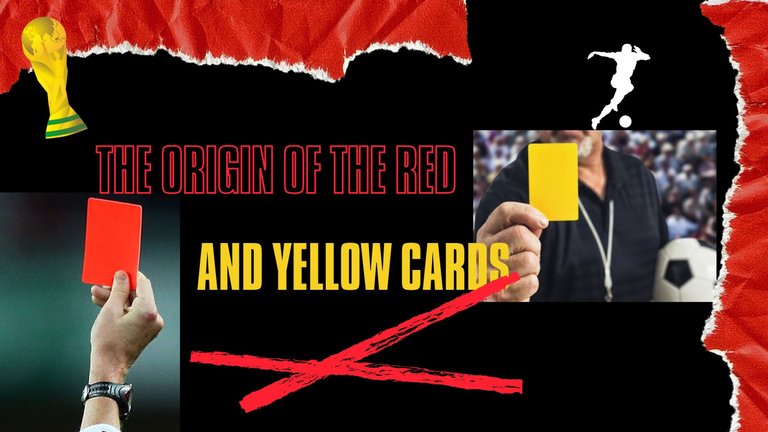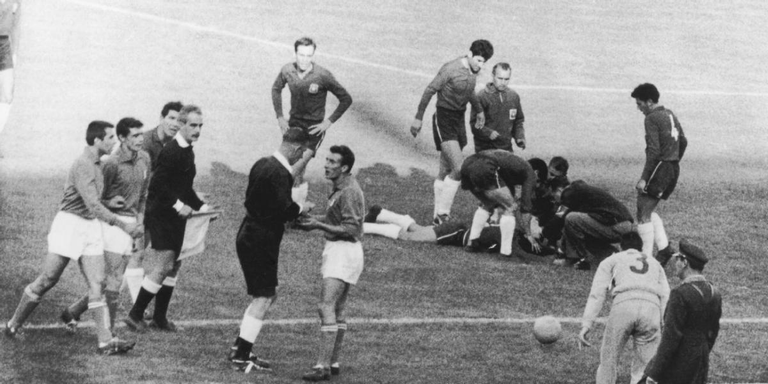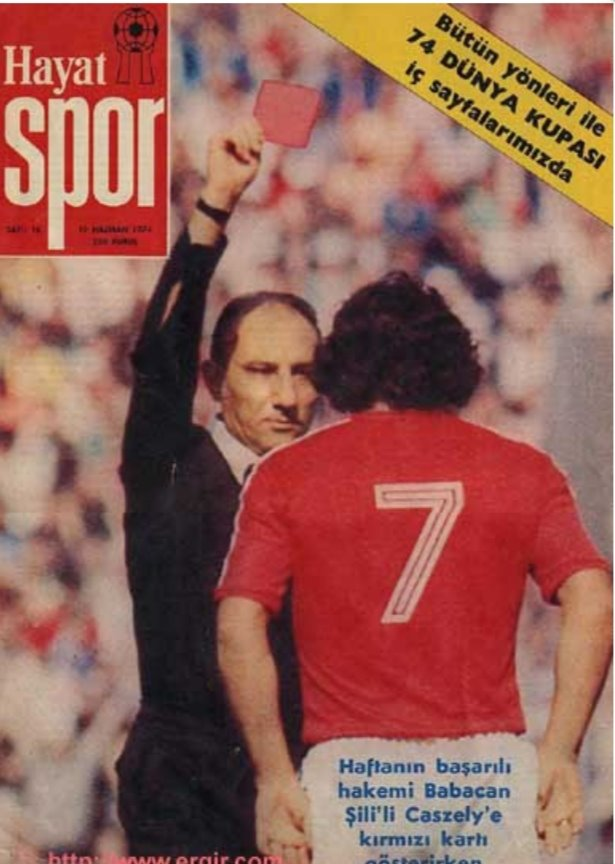The Origin of Red and Yellow Cards (ESP/ENG)

Portada diseñada por mi en el editor de Canva
Hello friends, in football, apart from penalty kicks, I think there is no moment of greater tension and fear for both players and fans than when a referee puts his hand in his pocket 😱 what he gets out of it could drastically affect a team, it is often said that behind this there is a lot of money involved, but that is another matter that we will not talk about today, today I want to share with you the result of my research about the origin of these yellow and red cards that referees use as punishment for undisciplined players... Who invented them and why? read on and you will find out.
Hola amigos, en el football, aparte de los tiros penalti, creo que no hay un momento de mayor tensión y miedo tanto para los jugadores como para los hinchas que cuando un arbitro se lleva la mano al bolsillo 😱 lo que saque de allí podría afectar drásticamente a un equipo, se dice muchas veces detrás de esto hay mucho dinero de por medio, pero ese es otro asunto en el que no vamos a ahondar, el día de hoy quiero compartir con ustedes el resultado de mi investigación acerca del origen de estas tarjetas amarillas y rojas que los árbitros usan como castigo para los jugadores indisciplinados... ¿quién las inventó y por qué? sigan leyendo y lo descubrirán.

Before, when tempers flared on the pitch, the belligerence of the players used to be uncontrollable, there was no way to make them keep their composure and they would even physically attack each other, unleashing chaos, as happened in the controversial match between the Soviet Union and Yugoslavia in the 1962 World Cup in Chile, 😱 Wow! We are talking about an opening match, not a final, but the players had so much passion and violence that this match left four people injured, and the injuries were quite considerable (fractures, cuts, etc).
Antes, cuando los ánimos se caldeaban dentro de las canchas, la beligerancia de los jugadores solía ser incontrolable, no había forma de hacer que guardaran la compostura e incluso llegaban a agredirse físicamente, desatando el caos, tal y como sucedió en el polémico partido entre La Unión Soviética y Yugoslavia en el mundial de 1962 en Chile, 😱 Wow! Estamos hablando de un partido inaugural, no de una final, pero a los jugadores les sobraba tanta pasión y violencia que este partido dejó un saldo de cuatro lesionados, y las lesiones fueron bastante considerables (fracturas, cortes, etc)

Later, in that same World Cup came the most violent match in history, all due to the fact that in that same year there had been a very strong earthquake in Chile which obviously affected the country a lot, even so it was able to recover and hold the World Cup, however, the Italian newspaper Il Resto del Carlino published an article discrediting the country, saying that it was full of prostitution, malnutrition and illiteracy, so on 2 June 1962, when the Chilean and Italian teams faced each other on the pitch, tempers were already running high, 7 minutes into the match, an Italian player committed a foul against a Chilean player, so the English referee, Kenneth George Aston, had to send him off the pitch, the Italian player refused to leave and had to be removed by the police. However, in the minutes that followed, a pitched battle broke out, a real war between players. This match was so violent that it became known worldwide as "The Battle of Santiago".
Posteriormente, en ese mismo mundial llegó el partido más violento de la historia, todo se debió a que en ese mismo año había ocurrido un terremoto muy fuerte en Chile que obviamente afectó mucho al país, aun así puedo recuperarse y llevar a cabo la copa del mundo, no obstante, el periódico Italiano Il Resto del Carlino publicó un artículo que desacreditaban al país, diciendo que estaba lleno de prostitución, desnutrición y analfabetismo, así que el 2 de junio de 1962, cuando las selecciones de Chile e Italia se enfrentaron en el terreno de juego, los ánimos ya estaban caldeados, a los 7 minutos del partido, un jugador italiano cometió una falta contra uno de Chile y por lo tanto el arbitro inglés, Kenneth George Aston, tuvo que echarlo de la cancha, el jugador italiano se negó a salir por las buenas y tuvo que ser retirado por la policía. Sin embargo en los minutos posteriores se desató una batalla campal, una verdadera guerra entre jugadores. Este partido fue tan violento que llegó a conocerse mundialmente como "La Batalla de Santiago"
Kenneth George Aston (the referee) kept thinking about this match and how he could avoid this kind of conflict, there had to be a way to impose discipline and respect on the pitch, then one day, while driving through the streets of London a simple traffic light gave him the solution, he stared at it while thinking about the meaning of the colours of two of the lights: yellow (you can still continue) red (stop! no chance to continue) this could also be interpreted as Get out!
Kenneth George Aston (el arbitro) se quedó pensando en este partido y en la forma en la cual podría evitar este tipo de conflictos, tenía que existir una manera de imponer disciplina y respeto en el terreno de juego, entonces un día, mientras conducía por las calles de Londres un simple semáforo le dio la solución, él se quedó contemplándolo mientras pensaba en el significado de los colores de dos de las luces: amarillo (aún puedes continuar) rojo (¡detente! ya no hay oportunidad para continuar) esto podría ser interpretado también como ¡Fuera!

After "The Battle of Santiago" and other violent matches in which Kenneth Aston was frustrated, he finally took the opportunity in 1966, when he was a member of the FIFA Referees Committee, to present his idea of preventing or sanctioning players through the use of red and yellow cards, the committee approved the request and they were finally used for the first time at the 1970 World Cup in Mexico, when Soviet player Kakhi Asatiani received a yellow card as a warning, while Chile's Carlos Caszely was the first to be sent off from a match through the use of a red card at the 1974 World Cup in Germany.
Luego de "La Batalla de Santiago" y otros partidos violentos en los cuales Kenneth Aston terminaba frustrado, finalmente en 1966 aprovechó la oportunidad de que formaba parte de la Comisión de árbitros de la FIFA, para presentar su idea de prevenir o sancionar a los jugadores mediante el uso de tarjetas rojas y amarillas, la comisión aprobó la solicitud y finalmente se usaron por primera vez en el mundial de México de 1970, cuando el jugador soviético Kakhi Asatiani recibió una tarjeta amarilla como advertencia, mientras que el chileno Carlos Caszely fue el primero en ser expulsado de un partido mediante el uso de una tarjeta roja en el mundial de Alemania 1974.


Well friends this has been all for today, I hope you liked having learned something new, because now you have one more topic of conversation to share with your friends, and if on the contrary you know something that I did not mention in this post, I would like to know what it is and thus feed back our knowledge. Thank you very much for your attention.
Bien amigos esto ha sido todo por hoy, espero que les haya gustado haber aprendido algo nuevo, ya que ahora tienen un tema más de conversación para compartir con sus amigos, y si por el contrario ustedes saben algo que no mencioné en este post, me gustaría saber de que se trata y así retroalimentar nuestros conocimientos. Muchas gracias por su atención.

Imagen diseñada por mi en el editor de Canva.
A continuación les dejaré la fuente de la página en la cuál encontré información valiosa para la realización de este post.
Here is the source of the page where I found valuable information for this post.
¡Enhorabuena!
✅ Has hecho un buen trabajo, por lo cual tu publicación ha sido valorada y ha recibido el apoyo de parte de CHESS BROTHERS ♔ 💪
♟ Te invitamos a usar nuestra etiqueta #chessbrothers y a que aprendas más sobre nosotros.
♟♟ También puedes contactarnos en nuestro servidor de Discord y promocionar allí tus publicaciones.
♟♟♟ Considera unirte a nuestro trail de curación para que trabajemos en equipo y recibas recompensas automáticamente.
♞♟ Echa un vistazo a nuestra cuenta @chessbrotherspro para que te informes sobre el proceso de curación llevado a diario por nuestro equipo.
Cordialmente
El equipo de CHESS BROTHERS
Muchísimas gracias por su apoyo.
I’ve always wondered how this red and yellow card thing came into the game.
😂😂That was an interesting video. I would pay millions to live that moment of the battle of Santiago😂. The passion, the love and dedication has never been seen before. I think if I was part of those days I would have enjoyed their matches more.
Aston did a great job to even see that match through in the first place. I think he was a highly respected referee hence no player tried to hit him. It was a great Idea and it has helped football.
The video is really interesting, just seven minutes into the match the fight started. It's true what you say about Aston, he must have had a lot of respect otherwise he would have been injured too 🤣. I used to think that yellow and red cards were invented along with football. Thank you very much for reading and commenting 😊